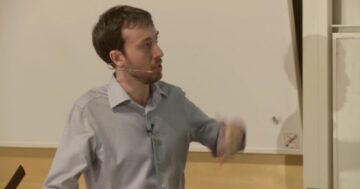Bradley and Luskin in Evolution News:
 In recent years, MIT physicist Jeremy England (pictured above) has gained media attention for proposing a thermodynamic energy-dissipation model of the origin of life. England’s view was summarized when he famously said that the origin and evolution of life “should be as unsurprising as rocks rolling downhill.” He continued, “You start with a random clump of atoms, and if you shine light on it for long enough, it should not be so surprising that you get a plant.”1Another physicist, ID theorist Brian Miller, has responded to England’s research.
In recent years, MIT physicist Jeremy England (pictured above) has gained media attention for proposing a thermodynamic energy-dissipation model of the origin of life. England’s view was summarized when he famously said that the origin and evolution of life “should be as unsurprising as rocks rolling downhill.” He continued, “You start with a random clump of atoms, and if you shine light on it for long enough, it should not be so surprising that you get a plant.”1Another physicist, ID theorist Brian Miller, has responded to England’s research.
Miller points out that the kind of energy that dissipates as a result of the sun shining on the Earth or other natural processes cannot explain how living systems have both low entropy (disorder) and high energy. As Miller puts it: “These are unnatural circumstances. Natural systems never both decrease in entropy and increase in energy — not at the same time.” Living cells do this “by employing complex molecular machinery and finely tuned chemical networks to convert one form of energy from the environment into high-energy molecules” — things that cannot be present prior to the origin of life because they must be explained by the origin of life. Without this cellular machinery to harness energy from the environment and drive down entropy, England’s energy-dissipation models cannot do the task they’ve been handed. As Miller said, England’s model cannot account for the origin of biological information, which “is essential for constructing and maintaining the cell’s structures and processes.”
More here.
